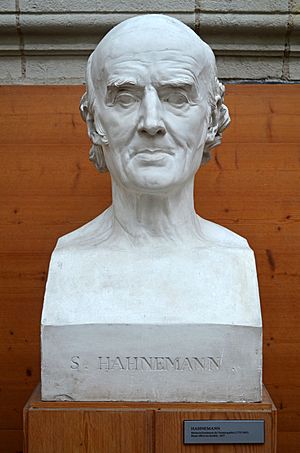Samuel Hahnemann facts for kids
Quick facts for kids
Samuel Hahnemann
|
|
|---|---|
 |
|
| Born | 10 April 1755 Meissen, Electorate of Saxony
|
| Died | 2 July 1843 (aged 88) Paris, France
|
| Nationality | German |
| Known for | Homeopathy |
Christian Friedrich Samuel Hahnemann (born April 10, 1755 – died July 2, 1843) was a German doctor. He is famous for creating a system of alternative medicine called homeopathy.
Contents
Early Life
Samuel Hahnemann was born in Meissen, a town in Saxony, which is near Dresden. His father, Christian Gottfried Hahnemann, was a painter and designed porcelain. Meissen is well-known for its beautiful porcelain.
When he was young, Hahnemann became very good at many languages. These included English, French, Italian, Greek, and Latin. He later earned money by translating and teaching languages. He also learned Arabic, Syriac, Chaldaic, and Hebrew.
Hahnemann studied medicine for two years in Leipzig. He then moved to Vienna to study for ten months. His teachers included famous doctors like Joseph von Quarin.
Hahnemann finished his medical studies at the University of Erlangen. He earned his medical degree with honors on August 10, 1779. He might have chosen Erlangen because the fees were lower there.
Medical Journey
In 1781, Hahnemann started working as a village doctor in Mansfeld, Saxony. He married Johanna Henriette Kuchler and they had eleven children.
He later stopped practicing medicine for a while. During this time, he worked as a translator of science and medical books. He translated many books from English, French, Latin, and Italian. Hahnemann moved around Saxony for many years. He lived in different towns like Dresden, Torgau, Leipzig, and Köthen (Anhalt). In June 1835, he finally moved to Paris.
Creating Homeopathy
Hahnemann was not happy with how medicine was practiced in his time. He especially disliked methods like bloodletting. He felt that some medical treatments he learned could harm patients more than help them.
He stopped his medical practice around 1784. He then made a living as a writer and translator. He also wanted to find out why he thought medicine had so many problems.
While translating a book by William Cullen, Hahnemann read that cinchona bark helped treat malaria. Cinchona comes from a Peruvian tree. Hahnemann thought other similar substances did not work against malaria. So, he decided to test cinchona on himself. He noticed it caused symptoms similar to malaria in his healthy body.
This made him think of a new idea: "What can cause symptoms in a healthy person, can treat a sick person who has similar symptoms." This idea, "like cures like," became the main rule for his new medical approach. He named it homeopathy. He first used this word in an essay in 1807.
Developing Homeopathy
Hahnemann continued to test different substances. He would see what effects they had on a healthy person. He believed that these substances could heal the same problems they caused. He found that toxic effects of some things were similar to certain diseases. This led him to believe in a general "law of similars."
He then found ways to dilute, or make weaker, the substances he was testing. This was to reduce their toxic effects. He claimed that these very diluted substances, when prepared in a special way he called "potentization" (using dilution and vigorous shaking), could still help sick people. He started using diluted Ipecacuanha for coughs and Belladonna for scarlet fever around 1800-1801.
He first wrote about his homeopathic ideas in a German medical journal in 1796. Later, in 1810, he published "Organon of the Rational Art of Healing." This book explained all his detailed instructions on homeopathy. He published several more editions of this book, which is now known as The Organon of the Healing Art.
Later Life

In early 1811, Hahnemann moved his family back to Leipzig. He wanted to teach his new medical system at the University of Leipzig. To become a teacher there, he had to write and defend a medical paper. On June 26, 1812, Hahnemann presented his paper in Latin. It was about the historical uses of a plant called Hellebore.

Hahnemann kept practicing and researching homeopathy for the rest of his life. He also continued to write and give lectures. He passed away in 1843 in Paris, at 88 years old. He is buried in the Père Lachaise Cemetery in Paris.
Writings
Hahnemann wrote many books, essays, and letters about homeopathy, chemistry, and general medicine. Some of his important works include:
- Fragmenta de viribus medicamentorum positivis sive in sano corpore humano obeservitis (1805), a collection of drug tests.
- The Organon of the Healing Art (1810), his main book explaining homeopathy.
- Materia Medica Pura (1811-1821), a collection of reports on how different substances affect people.
- Chronic Diseases (1828), which explained his ideas about long-term illnesses.
- The Friend of Health, where he suggested using fresh air, rest, good food, and sunshine for health.
- He also wrote about how to treat people with mental illness kindly in 1792.
See also
 In Spanish: Samuel Hahnemann para niños
In Spanish: Samuel Hahnemann para niños
- Hahnemann University Hospital

